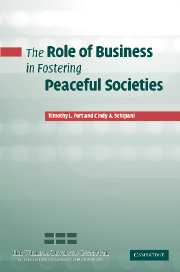Book contents
- Frontmatter
- Contents
- List of tables
- Acknowledgements
- Introduction
- Part I The plausibility of connecting business and peace
- Part II Current standards and their amenability to peace
- 3 Corporate governance and sustainable peace
- 4 Ethical business behavior and sustainable peace
- Part III Two illustrative issues: gender equality and ecology
- Conclusion
- Index
3 - Corporate governance and sustainable peace
Published online by Cambridge University Press: 22 September 2009
- Frontmatter
- Contents
- List of tables
- Acknowledgements
- Introduction
- Part I The plausibility of connecting business and peace
- Part II Current standards and their amenability to peace
- 3 Corporate governance and sustainable peace
- 4 Ethical business behavior and sustainable peace
- Part III Two illustrative issues: gender equality and ecology
- Conclusion
- Index
Summary
This chapter examines three models of corporate governance and considers whether it is feasible for these models to add peace to their objectives. Corporate governance has been defined generally as a top management process, that when operating correctly, should manage value creation and value transference among various corporate claimants in a way that ensures accountability toward those claimants. Claimants can be broadly defined to include all of those with a stake in corporate operations, including shareholders, customers, employees, suppliers, creditors, and the local community. This definition emphasizes both efficiency and fairness.
There are several different ways to approach issues of corporate governance. In the USA, dating at least back to 1919, when the famous case of Dodge v. Ford was decided, the approach has been a model that has focused primarily on the shareholder, the residual claimant of the corporate form. In Dodge v. Ford, the court specifically stated that a “business corporation is organized and carried on primarily for the profit of the stockholders.” In other regimes, such as Germany and Japan, the interest of society and employees have historically been the first focal point. All three regimes have had both prosperous as well as trying times.
Although these models, in some way or another, consider interests of various constituencies, including society at large, these models do not focus on the goal of peace as a general aspiration.
- Type
- Chapter
- Information
- The Role of Business in Fostering Peaceful Societies , pp. 91 - 108Publisher: Cambridge University PressPrint publication year: 2004

